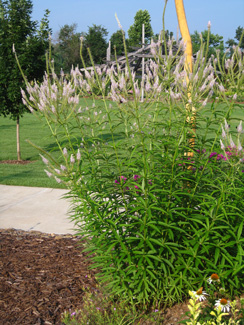Resource Library
Plant of the Week: Culver's Root
Wildflowers in the garden are becoming increasingly common as those interested in nature and gardens become more xenophobic about growing plants from foreign lands. One of the wildflowers being offered occasionally is Culver’s Root (Veronicastrum virginicum), a native throughout Arkansas and most of the eastern states.
Culver’s root is an herbaceous perennial now assigned to the plantain family that was for more than a century considered part of the foxglove family. It is the only North American species of the 20 known worldwide with most, 13, native to China. It grows 4 to 6 feet tall with stout, erect stems bearing whorls of three to nine lanceolate leaves up the stem that are 3 to 4 inches long.
In early to mid-summer, candelabra-shaped spiked, much-branched inflorescences are produced at the ends of the stems that are 6 to 9 inches long. Flower color is usually white but pinks and blue forms are seen, primarily as a result of hybridization with the Russian species. Individual flowers are tiny but produced in mass up and down the flowering spike. The fruit is a small, brown many-seeded capsule.
In nature, Culver’s Root usually grows in disturbed sites such as along roadsides, in moist meadows or in sunny but moist woodland glades. It grows throughout the eastern half of the U.S. and Canada, ranging as far south as East Texas and Florida. But throughout this range it is widely scattered and seldom found in high numbers.
When Linnaeus named this plant it was originally lumped with the somewhat similar veronicas but Thomas Nuttall, the first botanist to explore in Arkansas, reclassified it as Leptandra virginica. In the 20th century the name was finally changed to Veronicastrum which translates as “superficially resembles veronica”.
The common name Culver’s Root is an old one, apparently dating back to the end of the 18th century. In his 1813 book, Indian Doctor’s Dispensatory author Peter Smith uses the name and says his father used it for many years in his medical practice. Presumably an herbalist or doctor named Culver learned of the plant’s use in treating various digestive tract ailments from the native population.
Culver’s Root, while still available as an herbal extract, is mostly relegated to the flower border. It is a tall plant so best situated in the back of the sunny flower border or in the native garden near the wood’s edge. To keep the plants vigorous they should be divided once every four or five years in the spring. Several cultivars are available with differences primarily based on plant height or flower color.
By: Gerald Klingaman, retired
Retired Extension Horticulturist - Ornamentals
Extension News - May 2, 2014
The University of Arkansas System Division of Agriculture does not maintain lists of retail outlets where these plants can be purchased. Please check your local nursery or other retail outlets to ask about the availability of these plants for your growing area.
